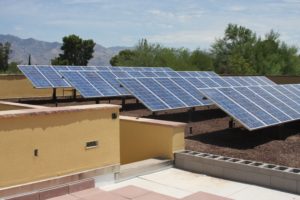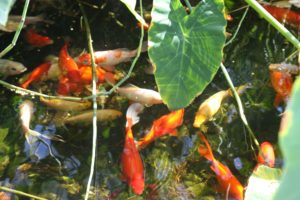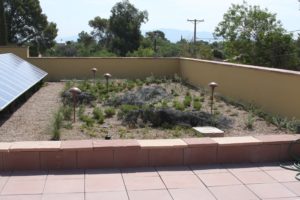Living Roof-Three concludes our three part series on the Living Roof Project. Living Roof-Three focuses on the roof itself with the solar panels and garden. Consult Living roof-One and Living Roof-Three for more project details as the designer traces his thoughts and decisions through the project. A project that has been a dream project for years and years.
Electrical
My dreams of solar farming remained on hold until TEP (the local electrical utility) offered a program for residential PV installations up to 10 kW to receive a rebate for tying into the grid. I had long waiting for the economics to become practical. I signed onto the program and bought my Kyocera panels long before I was able to actually install them. It was ironic to have to store them totally covered in the yard for over 5 years.
Power On
They are just now producing power, and even though the utility rebate has dropped from $3 per watt produced to $.75 and I will be receiving only a fraction of what I could have gotten if our project could have been online sooner.This doesn’t particularly bother me since it got the ball rolling on our project. It is obvious to me though that the utility companies will have to accommodate individual power production and remove barriers to participation (i.e. making a profit possible rather than only offering credit) for consumers and allow them to become net producers of electricity. There are security issues, as well as economic reasons to open up these relative monopolies, so that citizens can participate in the power grid.
First Try
The first iteration of the building design utilized Zomework tracking panels in the building design but this proved quite impractical. The next design integrated the PV panels into the garden design with steel standoff pipes attached to Uni-Rac brand struts that are manually adjustable for seasonal tuning. I read that the efficiency of panels is decreased by high temperatures of roof environments and hoped to mitigate that by combining the garden, which cools roof temperatures dramatically and also provides plant shading.
Panels Chosen
Kyocera panels consist of 48 panels on 4 arrays on roof garden and 56 on porch awning fixed with a 32 degree angle. There is also a 2 SMA grid tied inverters. This is where the electrical grid is the “battery” and credit is given for power produced which is rated at 11 kilowatts. We hope to have enough spare production to power an electric car from a 220 volt outlet in the garage.
Future Technologies
With future technologies in the pipeline promising energy storage innovations such as fuel cell storage, we are anticipating being able to generate and transfer power easily from home to battery to car, etc. If regulatory and utility hurdles were to be removed from home power production, where those who are now customers could become producers and broker their power the way the utility does across the national grid, especially beyond the 10 kW’s that TEP will sanction, I think that our energy independence and security would be assured.
Water
Water conservation is a survival issue here in Tucson where we have only 10” of rain yearly. Long term climate issues threaten future viability. Since moving to the desert in 1984, I have gained appreciation for the preciousness of this resource, beginning with using 55 gal. drums as storage and over flow for the washing machine and irrigating the plantings in our yard. This setup grew when I installed several 1000 gal. dough boy ponds and galvanized water troughs, stocked with papilla and floating plants.
Waste Management
Waste removal, a crucial factor for any population, became a valued resource, so we wanted to get the most out of it. We circulated the pond water into gravel filled trays planted with water chestnut and strawberries that breakdown the wastes and aerate the water. We then cycled it back into the pond. Orchards and gardens, planted near enough to benefit from the effluent, were robustly healthy, and I saw the system as something of an oasis on steroids.
Institutional Support
Much of this work was inspired by the work of The New Alchemy Institute (RIP) and the Environmental Research Lab at the UAunder the guidance of Carl Hodges. I constructed this with a minimal budget and was successful until too many fish were introduced to the system causing a population collapse and a plant fertilizer bonanza. This was a valuable lesson in maintaining balance. I have since lowered my ambitions in aquaculture to decorative ponds and waterfalls. We have had water features since moving to the Tucson desert and have found that running water is a crucial part of softening the desert’s heat and the urban noises.
Cistern Installation
The first major construction on this site was the burying of two 10,000 gal. concrete cisterns in the driveway area. I am glad that I had these “installed” first as the soil they displaced was easily larger than most backyard pools. They were engineered vaults, highway traffic rated, from Utility Vault, and came in pre-cast sections (6 total) that were craned into place and the lids buried. These proved their load bearing capacity many times over by the many cranes and concrete trucks rolling over them. They will have 6” drain pipes from the roof plumbed into a 500 gal. sand filter which will be piped into the cistern chambers.
Cistern Capacity
We figured that the cisterns could take in 6 months of rainwater which we could use in the landscape with minimal filtration and pumping. We also wanted to make it possible to use this water much more widely with greater filtration (ultra violet, activated charcoal, etc.) in the addition and beyond. The addition has dual plumbing where ever practical and a 20” industrial sized whole house filter will cover the system. The filter allows high flow rate and longer life than smaller ones and there are many options for the filter materials.
Gray Water
Gray water is gold, particularly in this climate with its sterile soil. I have always kept it simple with a hose and a barrel (which mitigates the flush of water from the washer) but hope to add greater flexibility and lessen pond and stagnancy problems by integrating a multi-zoned leaching system from the machine to several planting beds. This will be a variation on a gray water system Oasis Design (http://oasisdesign.net) which promotes many a dizzying array of alternatives for high tech pumping and filtration or gravity flow simplicity.
System Choice
I chose a system that would utilize the washer’s pump to propel the gray water 100 ft., downhill from the machine’s 3’ above grade outlet, into buried leaching fields surrounded by well mulched plants, especially bamboo. There are back flow preventives and other security measures to prevent contamination of the water line and the system can be monitored and flushed with city water periodically.
Hopes
I hoped to irrigate the roof with gray water but was dissuaded by the incoming water pressure and particularly by the contaminants in the water which would clog the engineered soil mix on the roof. There might be short term gain with this approach, but it would lead to clogged soil and drain problems eventually, so the Oasis gray water system was chosen. We are not ready to implement it at this point and I am preparing beds with mulch and composted materials which our pig, Zap, uses as a lounge on cooler days.
This concludes the three part series on our Living Roof Project. View Living Roof-One and Living Roof-Two for more details of the project start through the project finish.








